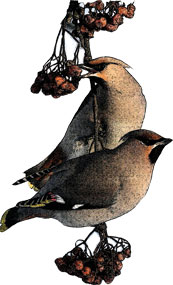 |
A Waxwing looks like a soft, buffish-brown chunky parakeet with a little crest of wispy feathers on top of its head and colourful wings. The whole effect topped off with a yellow bar at the end of its tail. The name waxwing comes from the noticeable red blobs the colour of sealing wax on its wingtips.
Ceiling Tax?
This is always quoted as a distinguishing feature; not any more. Just try to describe the colour of sealing wax to someone under 50; you will feel about a hundred and they will be none the wiser.
Waxwings are often seen in large groups, I saw 15 or 20 together on a rowan tree near the centre of St Albans in January. They fly about all together making a beautiful high-pitched twitter. Waxwings particularly like rowan and cotoneaster berries - that’s why you find them in supermarket car parks where these bushes and trees are often planted for their ornamental appeal. The surest sign that you have indeed seen waxwings is that they are the only buff-brown bird seen perching in groups in the UK during the winter months. |
Wanderers
Some winters, huge numbers of waxwings are seen in Scotland, the north of England and on down the east side of the country as far as London. Winters with exceptionally large numbers are known as Waxwing Winters. Around November last year there was talk of this being such a winter but in the end, not so many were seen. Because of this unpredictable behaviour, the waxwing is known as an irruptive species, rather than a truly migratory one: a wanderer, rather than a regular visitor.
Old wives tale?
Folklore has it that the birds fly southwards in order to avoid hard winters where they breed in Scandinavia and western Siberia. Not so. Waxwing winters are not related to the weather at all. If a good nesting season is followed by a shortage of berries, the waxwings will arrive in thousands. After a poor breeding season followed by plentiful berries; they stay at home in Siberia and eat the berries. |




